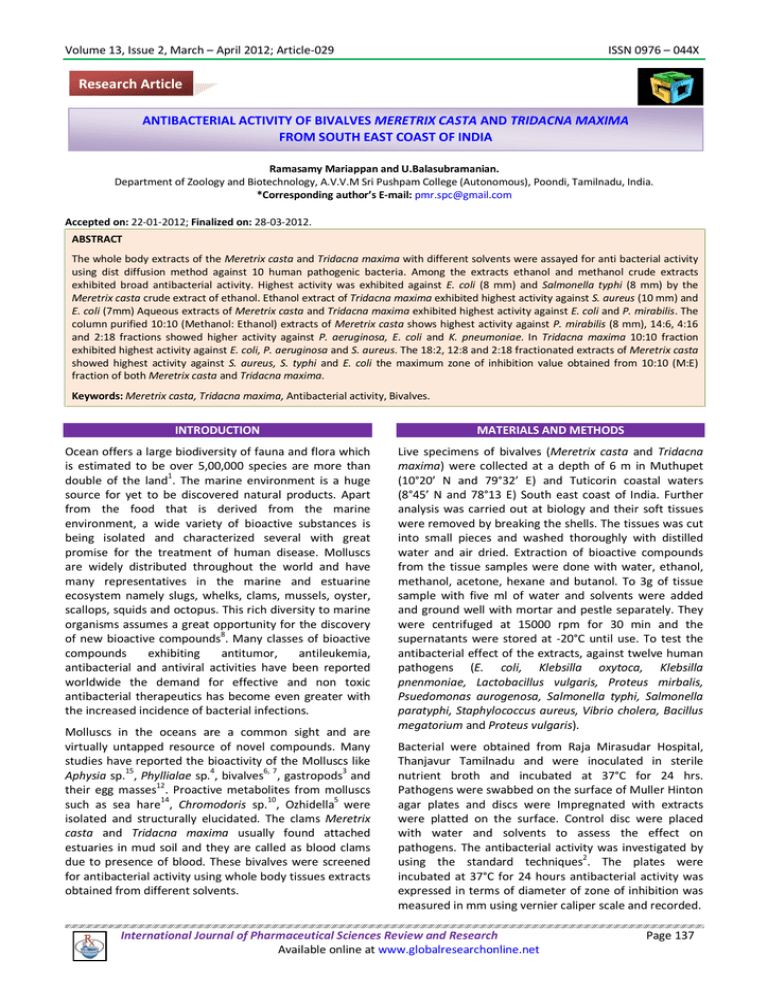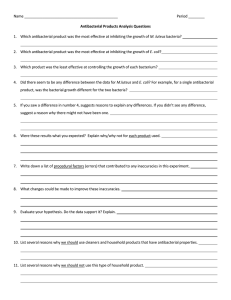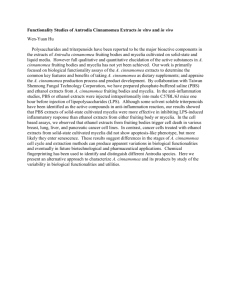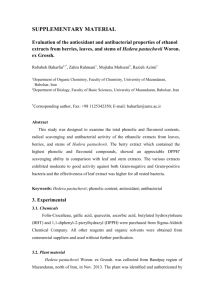Document 13308760
advertisement

Volume 13, Issue 2, March – April 2012; Article-029 ISSN 0976 – 044X Research Article ANTIBACTERIAL ACTIVITY OF BIVALVES MERETRIX CASTA AND TRIDACNA MAXIMA FROM SOUTH EAST COAST OF INDIA Ramasamy Mariappan and U.Balasubramanian. Department of Zoology and Biotechnology, A.V.V.M Sri Pushpam College (Autonomous), Poondi, Tamilnadu, India. *Corresponding author’s E-mail: pmr.spc@gmail.com Accepted on: 22-01-2012; Finalized on: 28-03-2012. ABSTRACT The whole body extracts of the Meretrix casta and Tridacna maxima with different solvents were assayed for anti bacterial activity using dist diffusion method against 10 human pathogenic bacteria. Among the extracts ethanol and methanol crude extracts exhibited broad antibacterial activity. Highest activity was exhibited against E. coli (8 mm) and Salmonella typhi (8 mm) by the Meretrix casta crude extract of ethanol. Ethanol extract of Tridacna maxima exhibited highest activity against S. aureus (10 mm) and E. coli (7mm) Aqueous extracts of Meretrix casta and Tridacna maxima exhibited highest activity against E. coli and P. mirabilis. The column purified 10:10 (Methanol: Ethanol) extracts of Meretrix casta shows highest activity against P. mirabilis (8 mm), 14:6, 4:16 and 2:18 fractions showed higher activity against P. aeruginosa, E. coli and K. pneumoniae. In Tridacna maxima 10:10 fraction exhibited highest activity against E. coli, P. aeruginosa and S. aureus. The 18:2, 12:8 and 2:18 fractionated extracts of Meretrix casta showed highest activity against S. aureus, S. typhi and E. coli the maximum zone of inhibition value obtained from 10:10 (M:E) fraction of both Meretrix casta and Tridacna maxima. Keywords: Meretrix casta, Tridacna maxima, Antibacterial activity, Bivalves. INTRODUCTION MATERIALS AND METHODS Ocean offers a large biodiversity of fauna and flora which is estimated to be over 5,00,000 species are more than double of the land1. The marine environment is a huge source for yet to be discovered natural products. Apart from the food that is derived from the marine environment, a wide variety of bioactive substances is being isolated and characterized several with great promise for the treatment of human disease. Molluscs are widely distributed throughout the world and have many representatives in the marine and estuarine ecosystem namely slugs, whelks, clams, mussels, oyster, scallops, squids and octopus. This rich diversity to marine organisms assumes a great opportunity for the discovery of new bioactive compounds8. Many classes of bioactive compounds exhibiting antitumor, antileukemia, antibacterial and antiviral activities have been reported worldwide the demand for effective and non toxic antibacterial therapeutics has become even greater with the increased incidence of bacterial infections. Live specimens of bivalves (Meretrix casta and Tridacna maxima) were collected at a depth of 6 m in Muthupet (10°20’ N and 79°32’ E) and Tuticorin coastal waters (8°45’ N and 78°13 E) South east coast of India. Further analysis was carried out at biology and their soft tissues were removed by breaking the shells. The tissues was cut into small pieces and washed thoroughly with distilled water and air dried. Extraction of bioactive compounds from the tissue samples were done with water, ethanol, methanol, acetone, hexane and butanol. To 3g of tissue sample with five ml of water and solvents were added and ground well with mortar and pestle separately. They were centrifuged at 15000 rpm for 30 min and the supernatants were stored at -20°C until use. To test the antibacterial effect of the extracts, against twelve human pathogens (E. coli, Klebsilla oxytoca, Klebsilla pnenmoniae, Lactobacillus vulgaris, Proteus mirbalis, Psuedomonas aurogenosa, Salmonella typhi, Salmonella paratyphi, Staphylococcus aureus, Vibrio cholera, Bacillus megatorium and Proteus vulgaris). Molluscs in the oceans are a common sight and are virtually untapped resource of novel compounds. Many studies have reported the bioactivity of the Molluscs like Aphysia sp.15, Phyllialae sp.4, bivalves6, 7, gastropods3 and their egg masses12. Proactive metabolites from molluscs such as sea hare14, Chromodoris sp.10, Ozhidella5 were isolated and structurally elucidated. The clams Meretrix casta and Tridacna maxima usually found attached estuaries in mud soil and they are called as blood clams due to presence of blood. These bivalves were screened for antibacterial activity using whole body tissues extracts obtained from different solvents. Bacterial were obtained from Raja Mirasudar Hospital, Thanjavur Tamilnadu and were inoculated in sterile nutrient broth and incubated at 37°C for 24 hrs. Pathogens were swabbed on the surface of Muller Hinton agar plates and discs were Impregnated with extracts were platted on the surface. Control disc were placed with water and solvents to assess the effect on pathogens. The antibacterial activity was investigated by using the standard techniques2. The plates were incubated at 37°C for 24 hours antibacterial activity was expressed in terms of diameter of zone of inhibition was measured in mm using vernier caliper scale and recorded. International Journal of Pharmaceutical Sciences Review and Research Available online at www.globalresearchonline.net Page 137 Volume 13, Issue 2, March – April 2012; Article-029 ISSN 0976 – 044X Antibacterial activity of fractioned bivalve extracts Ethanol and Methanol extracts showed high inhibitory activity than the other extracts and these extracts were fractioned by column chromatography in Silica gel. Elution were made with, ethanol (E) methanol (M) and the ethanol and methanol in different proportion ethanol alone. 18:2, 16:4, 14:6, 12:8, 10:10, 8:12, 6:14, 4:16, 2:18 and methanol alone. Thus 11 fractions were collected separately and tested against twelve bacteria. RESULTS AND DISCUSSION From the antibacterial activity six solvents extracts, of Meretrix casta and Tridacna maxima the ethanol and methanol extracts were able to inhibit all the pathogens exhibiting broad spectral antibiotic activity (table 1). Ethanolic extracts from Meretrix casta on pathogenic bacteria showed, highest activity was against E. coli (8 mm). The lowest activity was found with acetone, hexane and butanol extracts against K. oxytoca and Vibrio sp. From the antibacterial activity of Tridacna maxima water and methanol extracts showed highest activity against E. coli (7 mm) and Klebsiella oxytoca (10 mm) (table 2). Table 1: Antibacterial activity of Meretrix casta (Chemintz) against human pathogens Zone of inhibition Pathogens Water Ethanol Methanol Acetone Hexane Butanol Escherichia coli 4 8 2 1 Klebsiella oxytoca T 2 T K. pneumoniae T T Lactobacillus vulgaris T T T Proteus mirabilis 1.5 4 2 1.5 1.5 Pseudomonas aeruginosa T 1 Salmonella typhi 3 7 3 2 1 1 S. paratyphi 1.5 3 1 Staphylococcus aureus 3 8 2 2 1 1 Vibrio sp. T T Bacillus megatorium 3 T 2 1 1 Proteus vulgaris 2 3 2 1 T Table 2: Antibacterial activity of Tridacna maxima against human pathogens Zone of inhibition Pathogens Water Ethanol Methanol Acetone Hexane Escherichia coli 3 7 2.5 1 Klebsiella oxytoca 1.5 4 5 T K. pneumoniae T 1 Lactobacillus vulgaris T Proteus mirabilis 4 3 4 1 Pseudomonas aeruginosa T T 1 Salmonella typhi 2 6 3 2 1 S. paratyphi T 3 1 Staphylococcus aureus 4 3 1 Vibrio sp. T T T Bacillus megatorium 3 2 1 T Proteus vulgaris 4 2 1 T - Butanol T T 1 T Table 3: Antibacterial activity of column purified fractions of Meretrix casta (Chemintz) in Ethanol and Methanol Zone of inhibition (mm) Name of the bacteria (E:M) E 18:2 16:4 14:6 12:8 10:10 8:12 6:14 4:16 2:18 M Escherichia coli 2 1 2 2 1 8 2 T 9 T Klebsiella oxytoca 1 1 T 1 2 T 1 K. pneumoniae 2 1 T 1 2 1 2 1 1 1 Lactobacillus vulgaris T 3 1 T T T 2 Proteus mirabilis 2 4 1 2 2 3 T 1 1 Pseudomonas aeruginosa T 1 3 1 5 Salmonella typhi 1 T 1 7 1 T 1 S. paratyphi 1 T 1 1 T Staphylococcus aureus 2 1 2 1 4 1 4 1 1 Vibrio sp. T T T T Bacillus megatorium 3 1 T 1 2 T 1 2 1 T Proteus vulgaris - : No activity; T : Trace International Journal of Pharmaceutical Sciences Review and Research Available online at www.globalresearchonline.net Page 138 Volume 13, Issue 2, March – April 2012; Article-029 ISSN 0976 – 044X Table 4: Antibacterial activity of column purified fractions of Tridacna maxima in Ethanol and Methanol Zone of inhibition (mm) Name of the bacteria (E:M) E 18:2 16:4 14:6 12:8 10:10 8:12 6:14 4:16 2:18 M Escherichia coli 2 1 2 2 1 8 2 T 9 T Klebsiella oxytoca 1 1 T 1 2 T 1 K. pneumoniae 2 1 T 1 2 1 2 1 1 1 Lactobacillus vulgaris T 3 1 T T T 2 Proteus mirabilis 2 4 1 2 2 3 T 1 1 Pseudomonas aeruginosa T 1 3 1 5 Salmonella typhi 1 T 1 7 1 T 1 S. paratyphi 1 T 1 1 T Staphylococcus aureus T 10 T 1 6 T T 2 1 T Vibrio sp. T 1 1 1 1 1 Bacillus megatorium 3 1 T 1 2 T 1 2 1 T Proteus vulgaris 2 1 T 1 2 T 2 1 1 1 - : No activity; T : Trace Antibacterial activity of fractioned extracts The extract were fractionated by silica gel column chromatography and highest activities were observed with the extracts of Meretrix casta against Proteus mirabilis (8 mm), E. coli (5 mm) and Staphylococcus aureus (4 mm) and Klebsiella pneumoniae (6 mm). In Tridacna maxima, the fraction of (E:M) 18:2, 10:10 and 2:18 displayed highest activity against Staphylococcus aureus (10 mm), Proteusmirabilis (8mm) and E. coli (9 mm). 18:2, 12:8, 2:18 fractions exhibited activity against Proteus mirabilis (4 mm), Salmonell typhi (7 mm) and Pseudomonas aeruginosa (5 mm). Mostly 10:10 fraction showed activity against all pathogenic bacteria. In 6:14 and 14:6 fractions of both animals showed very less activity against all pathogenic bacteria (table 3 and 4). In the present investigation, distinct antibacterial activity was observed against almost all the twelve pathogenic bacteria. Ethanol extracts of Meretrix casta showed highest activity against E. coli, S. aureus and aqueous extracts showed highest activity against E. coli, S. typhi and S. aureus, respectively and other extracts showed lowest activity against K. pneumoniae and L. vulgaris. Similarly the ethanol extract of Tridacna maxima exhibited highest activity against K. oxytoca, P. mirabilis and S. aureus, K. pneumoniae and L. vulgaris were highly resistant to all the extracts. Antibacterial activity of four bivalves against few pathogens and the extracts showed significant activity against Bacillus subtilis and gastropods against S. typhi were reported. Similar antibacterial activities in ethanol extracts of gastropod Babylonia spirata and Turbo brumneus and observed highest activity against E. coli, K. pneumoniae, P. vulgaris and S. typhi. Difference in antibacterial activity found with bivalve extracts may depend extracting capacity of solvents and compound extracted. The most interesting results were found with fractionated extracts of Meretrix casta against P. mirabilis, E. coli, S. aureus and P. aeruginosa. The (M:E) 14:6, 10:10 and 2:18 (M:E) fractions showed significant activity against P. aeruginosa, E. coli and Proteus mirabilis. Extracts from Meretrix casta with 10:10 fractions showed significant activity against most of the pathogens tested. Similar antibacterial activity with (M:E) 10:10 fraction of Tibia delicatula and these results complementing the results of present study.13 In this study extracts of Tridacna maxima with 18:2 and 2:18 (M:E) fraction showed highest activity against S. aureus and E. coli. The 10:10 fraction showed prominent activity against E. coli, P. mirabilis, P. aeruginosa and S. aureus. When compared to all solvents used, Ethanol, Methanol and Water elute the antibacterial bioactive compounds from the animals. The hypobranchial glands of Chicoreus virgineus and egg capsular of Rapara rapiformis extracted with polar solvents like ethanol and methanol also reported to show wide spectra activities. Lesser degree of inhibition by the column fractionated extracts in comparison to the crude could be opined that the active compound may have degraded or modified during the fractionation process. CONCLUSION In conclusion present study indicates the whole body extraction of Meretrix casta and Tridacna maxima would be a good source of antibacterial agents and would replace the existing inadequate and cost effective antibiotics. Further studies are needed to elucidate structure and mechanism of action of these marine molluscan extracts. Acknowledgements: The authors are thankful to Our Secretary and Correspondent Sriman Ayya for provided required facilities of our college. REFERENCES 1. Anand, T.P., J. Rajaganapathi and J.K. Patterson Edward, Antibacterial activity of Marine Mollusks from Port Nova region. Indian J. Mar. Sci., 26: 1997, 206-208. 2. Bauer, A.W., Kirby, W.M.M., Sherris, J.C. and Turck, M., Antibiotic susceptibility testing by a standardized single disc method. Am. J. Clini. Pathol., 45: 1996, 493-496. 3. Emerson Kagoo, L. and Ayyakkannau, K., Bioactive compounds from Chicoreus ramosus – antibacterial activity. In vivo Phuket Mar. Biol. Cent. Spl. Pub., 11: 1992, 147-150. International Journal of Pharmaceutical Sciences Review and Research Available online at www.globalresearchonline.net Page 139 Volume 13, Issue 2, March – April 2012; Article-029 4. Ilagedone, M.R., Barreson, B.J. and Schener, P.J., Bioactive natural products, Halvetica chemica acta, 62: 1999, 24842486. 5. Ireland, C., Copp, B., Foster, M., Mcdonald, L., Radisky, D. and Swersy, J., Biomedical potential of marine natural products. Mar. Biotechnol., I: 1993, 1-43. 6. Jayaseeli, A.A., Prem Anand, T. and Murugan, A., Antibacterial activity of four-bivalves from Gulf of Mannar. Phuker Mar. Biol. Cent. Spl. Pub., 25: 2001, 215-217. 7. 8. 9. Jayaseeli, A.A., T.P. Anand and A. Murugan, Antibacterial activity of in the opercula of gastropods, Phuket Mar. Biol. Centre.spl. pub.25: 2001, 215-217. Jhonson, M.W. and Soderhall, K., Exocytosis of the prophenoloxidase activating system from cray fish heamocytes. J. Com. Physiol., 15: 1985, 175-181. Kamboj, V.P., Bioactive agents from the ocean Biota: In ocean Science Trends Future directions. Somayajuly BLK (Ed.), Indian National Science Acadamy, New Delhi, India, 1999, 197-227. ISSN 0976 – 044X nudibranch, chromodoris carae. Can. J. Chem., 69: 1990, 768-771. 11. Pettit, G.R., Heral, C.L., Boyd, M.R., Leet, J.E., Burfrese, C., Doubek, P.L. and Schimidt, Antineoplastic agents. Isolation and structure of the growth inhibitory constituents from the western pacific marine sponges Axinella sp. J. Med. Chem., 34: 1991, 3339-3340. 12. Prem Anand, T., Raja Ganapathy, J. and Patterson Edward, J.K., Antibacterial activity of marine molluscs from portnovo region. Indian J. Mar. Sci., 26: 1997. 206-208. 13. Rajaganapathi, J., S.P. Thiyagarajan and J.K.P. Edward, Study on Cephalopod Ink for antiroviral activity, J. Exp. Biol., 38: 2000. 519-520. 14. Schmitz, F.J., Bowden, B.F. and Toth, S.I., Antitumor and cytotoxic compounds from marine organisms marine biotechnology, I: 1993. 197-208. 15. Stallard, M.O. and Faulkner, D.J., Marine natural products from molluscs. J. Comp. Biochem. Physiol., 49: 1974. 2532.s 10. Morris, S.A., Desilva, E.D. and Anderson, R.J., Chromodorame diterpenese from the tropical dorid ********************** International Journal of Pharmaceutical Sciences Review and Research Available online at www.globalresearchonline.net Page 140







